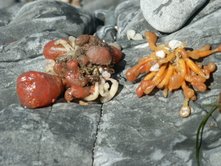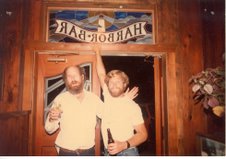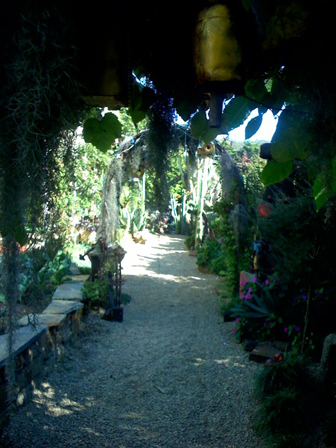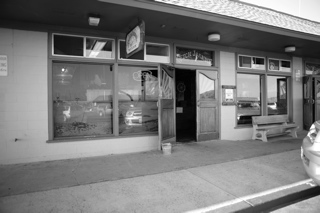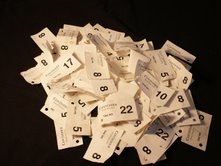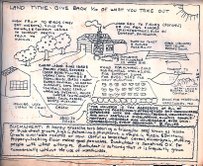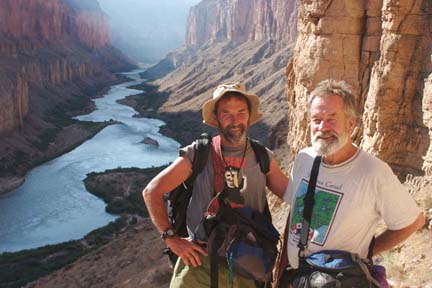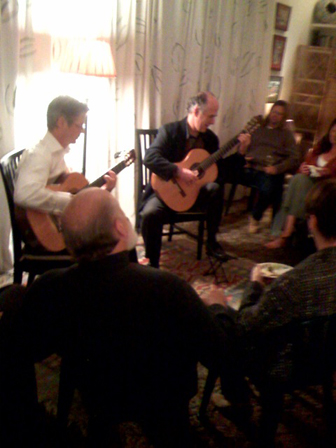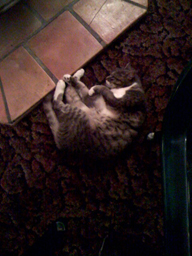To read John Vonderlin’s stories about “clusters” & things, click here
After & Before: We hear from stainglass craftsman Peter Adams….
Peter Adams: After (left) & Before (right)
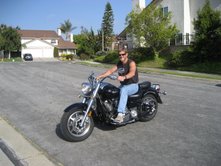
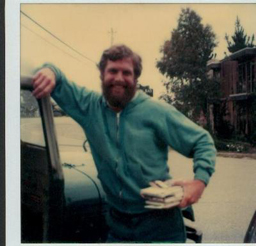
peter adams wrote:
bruce pine, richard english, bryant wollman, joanne [i did all their windows], joni [hi joni!] — all these friends from the past, wow!
(Photo: Peter Adams’ stained glass window at the Harbor Bar, Ketch Joanne. Peter (at right) with friend Edwin Booth.)
Leon’s Garden in El Granada
Joanne & The Ketch
I was thinking about the Ketch Joanne today–the no frills, honest homecooking restaurant that has been a friendly place to dine– at Pillar Point Harbor for several decades.
I’ve always admired Joanne Franklin, the strong woman, who, almost singlehandedly, established and turned the Ketch into the popular place it has become. She did everything herself–has anyone given her a gold medal?
In the early years of the business, the entire Franklin family worked there–Wendy, Heidi and Johann. Who can forget watching them all grow up? Anyone who ate there regularly became part of the extended Franklin family.
I just realized I’m overdue for Joanne’s terrific clam chowder!
Bay to Lake: A Failed 1940s Plan Would Have Turned
San Francisco Bay Into Two Lakes by June Morrall
In the early 1940s Redwood City resident Francis G. Hutchinson attended a meeting that featured John Reber, “the man who wanted to remodel San Francisco Bay.”
As Hutchinson listened closely, the author of the controversial “Reber Plan” explained how his “super-colossal” job of geographic re-configuration would effect the Peninsula.
Standing before a small audience in a Sequoia High School classroom, John Reber, a retired actor, pointed at detailed maps and charts, rendered by the eminent San Francisco structural engineer, L.H. Nishkian.
Exuding the polish of a “dignified politician,” Reber described building earth-and-rock-filled dams at the northern and southern ends of San Francisco Bay which would create two huge freshwater lakes, connected by a freshwater ship channel. As causeways, these dams would carry as many as 32 lanes of automobile traffic, as well as railroad tracks.
Continue reading “Bay to Lake: A Failed 1940s Plan Would Have Turned”
The Story of the “Tags” Dr. Science found at Invisible Beach, South of HMB
1972-73: The Story of “Farmers’ Feed,” the Coastside’s Food Co-Op by Michaele Benedict
The Story of “Farmers’ Feed: by Michaele Benedict***
In 1972 and 1973 dwellers âin the boonies near and about Half Moon Bay, Californiaâ? formed a food club which they called Farmersâ Feed. Members published a slender volume, the Farmersâ Feed Book, whose contents included recipes and articles on beekeeping, homemade animal feeds, companionate planting, goat-keeping, sprouts, chicken raising, and even a chicken vocabulary.
The introduction to the book said âFarmersâ Feed is a cooperative food purchasing and distributing group whose members live in the country south of Half Moon Bay, California. Almost our only common denominator is our countryness. Some of us are strict organic vegetarians and some secretly indulge in supermarket prepared foods in darkened attics. What unifies us is that we are all ex-urbanites come to roost in the same peaceful rookery. We make our living writing, breeding horses, teaching, drawing, building, filming, planning. This cookbook reflects our diversity. We hope you and your beasts enjoy our country table.â?
(Image: Land tithe, courtesy Mikie Benedict.)
The book urged a land tithe: Put back a tenth of what you take from the earth.
Contributors to the book were Suzanne White, Gene Fleet, Bryant Wollman, Valerie Hawes, Toni De Bari, Patrick Kitchen, Laurel Jernigan, Stanley Scholl, Barbara Freeman and Michaele Benedict.
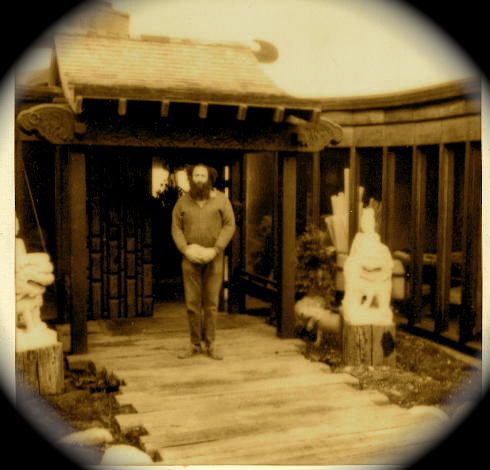 (Image: Bryant Wollman was a member of the Farmers’ Co-op. For many years he lived at rural Tunitas Creek and worked at the post office in Half Moon Bay. He is posing in front of the world-famous magician Channing Pollock’s home in Moss Beach, circa 1979. )
(Image: Bryant Wollman was a member of the Farmers’ Co-op. For many years he lived at rural Tunitas Creek and worked at the post office in Half Moon Bay. He is posing in front of the world-famous magician Channing Pollock’s home in Moss Beach, circa 1979. )
Advertisers and well-wishers were The Abalone Shop, Palace Ranch, Tunitas Glen Gardens, the Great White Whale Company, Hawes Place, Garret Gallery,
Hansel-Freeman Apple Works, the Water Works, Take 313, Ford Sunshine Company, and Ed Johnson, the Agricultural Extension Agent.
Farmersâ Feed members took turns shopping for bulk food items, mostly in Santa Cruz. In fall of 1972, they put on a theatrical production, âThe Ballad of Spanishtown Sueâ?, first at the Hawes Ranch and later at the Bach Dancing and Dynamite Society.
————–
***Author Michaele Benedict lives in Montara. To read Mikie’s “Searching for Anna” website click here
OceanStudio.org Goes to the Colorado River on a Real “Macho-Man” Adventure…
Photo: L-R Miramar Beach’s Michael Powers & former Coastsider Mark Fraser
For adventurers only click here
Day dreaming through Moss Beach
This morning, early, I drove to Moss Beach, to the west side near the Fitzgerald Marine Reserve. I wanted to see if Charlie Nye’s “Reefs II” was still there, at Nevada & Beach Streets; I heard that the historic building was gone.
Even though you’d think it would be easy to keep in touch with the communities of Montara, Moss Beach, Princeton, El Granada and Miramar, it isn’t–you can go decades without seeing someone who used to be your best friend or your former next door neighbor.
You can also go for years without knowing if your favorite old building is still standing.
I think Coastsiders get lost in their neighborhoods. I do, in mine, in El Granada, living on an avenue created by the designer of the Ocean Shore Railroad’s “showplace.” I can stay here for days without seeing anybody and feeling very happy about it!
People who do not live on the Coastside have no idea how good life is here.
Just recently a lady who works for Bank of the West in Burlingame told me how amazed she was to find that there were such beautiful, intimate communities off Hwy 1.
Here’s the point of this post: I drove up to Moss Beach to see if Nye’s Reefs was still there and I ended up at Nevada & I forget what the cross-street was. I didn’t see Nyes where it used to be.
This is embarrassing: Maybe I didn’t end up on the right street–now I’m not sure. Guess I’ll have to go back up there and check it out again. But the Moss Beach I saw this morning was very different from the one I remember just a few years ago when there were still many 1920s-style bungalows around.
Today I saw much larger, affluent landscaped homes reminding me of how long it had been since I visited the west side of Moss Beach.
Pasero-Patterson Duo Classical Guitar Recital: A Night To Remember At Miramar Beach
Friday night Burt and I were invited to hear a duo classical guitar recital at the Miramar Beach home of artist Linda Montalto-Patterson and her musicial-genius husband Richard Patterson. Richard was joined by acclaimed guitarist Stevan Pasero.
The fantastic sounds of the guitars took the rapt listeners on a musical adventure to South America; Brazil, Uruguay and Venezuela–to Cuba–and back to the USA with the standard jazz classic, “Sweet Georgia Brown,” and the melancholy folk song, “O Shenandoah.”
(Photo: Stevan Pasero, seated at left, Richard Patterson, at right.)
One of the final pieces Richard and Stevan performed to perfection came as a surprise, and as a nod to the generation of the guitarists’ guests–Led Zeppelin’s famous “Staircase to Heaven.”
At times, the exquisite technical skills of the musicians stunned the audience.
Being there reminded me of how tight-knit the Miramar Beach community is. It always has been. Many of the guests lived on the “strip”, Mirada Road, overlooking the Pacific Ocean. Some were old friends I hadn’t seen in many years–which was a delight as well.
A perfect evening at Miramar Beach.
(Image of the Patterson’s cat)
For more info about Richard Patterson’s music click here

